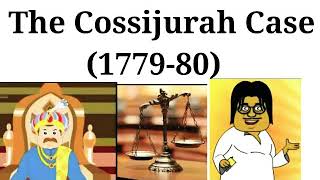The Cossijurah Case (1779-80)
The Cossijurah Case illustrates another aspect of the East India Companies administration in India. The Cossijurah case raised the defects of charter of 1774 which created the Supreme Court at Calcutta. The Charter did not specify either the the jurisdiction of the Court or the position of the Governor-General-in-Council. As a result of this confusion, there were occasions of conflicts between Supreme Court and the Council. In the Cossijurah case the confrontation between Supreme Court and the Council became evident to the highest degree. This case in brief as follows,
Raja Subramaniam, Zamindar of a Cossijurah was under a heavy debt of Cossinaut Babu. Although several methods were undertaken by Cossinaut to recover his debt from Raja Subramaniam, he was not able to recover his money. As Cossinaut had no other option/recourse left he knocked the doors of the judiciary. He filled a case against Raja Subramaniam by instituting a civil suit in The Supreme Court. A Writ of Capias by the court to arrest The Raja. As the Raja being scared of writ hid.
The council released an advisory that all landholders need not pay attention to the Supreme Court process until and unless they were serving the company or accepted the Court’s jurisdiction by their consent. The Raja was informed in particular about the advisory and therefore his people drove away the Supreme Court sheriff when he came with the writ to arrest the Raja.
The Supreme Court issued another writ of Sequestration, on the 12th of November 1779 to seize the Raja’s house, to force him to appear before the supreme court. The Raja was imprisoned by the officials and in doing so they outraged the holy sanctum of the house.
Meanwhile, Colonel Ahumty – Commander of the British Armed Forces of India was ordered by The Governor-General and the Council to arrest the Sheriff and release the Raja. On the 3rd of December 1779, the sheriff was arrested and confined for three days and sent to Calcutta as a prisoner. Finally, the sheriff was released under the council’s instructions. Later, Cossinaut Babu instituted a case against the Governor-General, which he refused to accept as he was on official duty.
The Council declared that the interest of the natives would be protected at all costs. The army Officials declared that the Supreme Court Officials could not issue writ’s to the Council members. The Judges of the Supreme Court felt insulted as a natural as their authority was undermined. The Supreme Court took an action against North Naylor the companies attorney General As the council member could not be served writ’s. North Naylor was sentenced to prison with no bail application provision, as the punishment was exemplary. The Council members still had to undergo civil action.
Questions Raised in Cossijurah Case
The Cossijurah Case raised two important questions, whether the Zamindars came under the Supreme Court Jurisdiction.
Who was the competent authority to decide this case?
To resolve the many defects of the Supreme Court acts the Parliament was compelled to pass The Act of Settlement (1781)
Author: Samar Jain,
SYMBIOSIS LAW SCHOOL 1ST YEAR


some facts are wrong